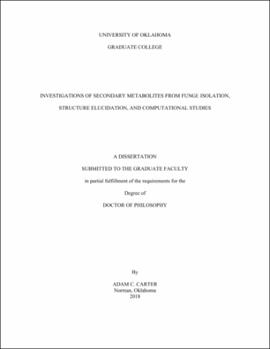| dc.description.abstract | Natural products have served as therapeutic agents in the treatment of many human health ailments for thousands of years. In order to find new therapeutic agents for future human health problems, those in the field of natural product drug discovery will need to take advantage of technological advances in screening capabilities such as high-content imaging-based assays for the identification of promising lead compounds, as well as computational calculations to aid in natural product structure determination and chemical reactivity studies. The research reported in this dissertation demonstrates the applications of these methodological approaches in three applications.
Trichomonas vaginalis is a sexually transmitted parasite that infects at least 170 million people worldwide and current treatments are limited to a single therapeutic agent, metronidazole. As a result, there is a need for new drug leads to treat this as well as other anaerobic parasites. To address this need, a high-throughput imaging-based assay was developed to screen a fungal crude extract library for inhibition of T. vaginalis and Ect1/E6E7 human cervical cells. This information was used to determine selectivity indices (SIs), and bioassay-guided fractionation led to the purification of promising leads that inhibit T. vaginalis while remaining safe to human cells. We found that the quinone-containing compounds fusarubin (SI=30) and xanthoquinodin A1 (SI=20) were promising leads, but as quinones are known to have indiscriminate activities, further protocols were developed to probe the potential liabilities of these compounds. Manipulation of oxygen levels led to a loss of potency in fusarubin, while xanthoquinodin A1 inhibited Lactobacillus acidophilus, a beneficial bacterium found in the vaginal tract. As such, we determined that while quinones show antitrichomonal activities, these compounds should be approached with caution when considering them as leads.
Aflatoxin B1 (AfB1) is a mycotoxin with tremendous health impacts as it is widely considered one of the most potent liver carcinogens known to humankind, and billions of people worldwide are exposed to it through their diets. While efforts have been made to find small molecules capable of protecting the liver from AfB1, there has been little success. In order to address this problem, we developed a high-throughput and high-content screening assay to identify and test natural products that are capable of protecting HepG2 liver cells, grown as monolayers and spheroids, against AfB1 toxicity. The use of spheroids proved to be excellent for the production of in vivo sensitivity of HepG2 cells under in vitro conditions, and led to the identification of two promising compounds, alternariol-9-methyl ether (purified from an Alternaria alternata isolate) and 1-hydroxy-3-methoxyxanthone, as potential future starting points for the development of new AfB1-protective agents.
Finally, Ewing sarcoma, while rare, is a debilitating disease affecting primarily children, teens, and young adults. Through a screening of fungal extracts, we identified a Rhizopus microsporus isolate containing the endosymbiotic partner Burkholderia rhizoxinica that produced an extract showing potent and selective inhibition of Ewing sarcoma cell lines. Bioassay-guided fractionation led to the purification of the known antimitotic agent rhizoxin and five new analogs. The structures of these analogs were determined through the use of NMR data analysis, and configurations of new stereocenters were established through the use of ROESY spectra in conjunction with computational calculations of chemical shifts and 3JHH coupling data. While rhizoxin was determined to have selectivity for a subset of Ewing sarcoma cell lines, the new analogs were found to be inactive. However, one analog stood out chemically as it contained a 15-membered macrolactone that was previously not reported for this class of compounds. Using a combination of degradation experiments and computational calculations, we determined that this compound likely arose through an acid-catalyzed Meinwald rearrangement of rhizoxin as a result of the mildly acidic environment created by R. microsporus and its bacterial endosymbiont. | en_US |
